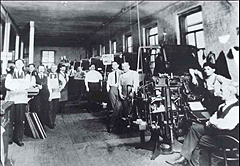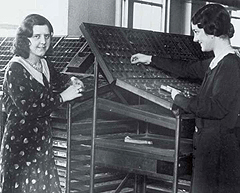Newspaper Union Survives 150 Years of Changes, Then All But Disappears
June 30, 2003
(This article was first published in the July/August 2003 issue of The American Postal Worker magazine.)
In the middle of the 15th century, Johannes Gutenberg combined his knowledge of molten metal with a colleague’s wine press to create the first publication to rely on reusable type.
The German goldsmith’s invention of “movable” type launched both a printing revolution and a craft. For about 400 years, skilled “printers” arranged and set the type in place by hand, and were the indispensable link between an author and the published page. During that time, there was little change in the basic technology of creating a publication, so it’s not surprising that printers banded together to form some of the first labor unions.

Because they were both labor intensive and produced on a regular cycle, newspapers traditionally were the main source of work for printers, and were among the earliest places to see collective job action: A walkout by a group of journeymen at the New York Gazette in 1778 is considered the first labor strike in the United States.
Most of the early printers’ organizations were benevolent societies rather than trade unions.When they struck or otherwise acted as unions, they tended to dissolve shortly after their demands had been met.
One early union that didn’t disappear was the Columbia Typographical Union, based in Washington, DC. While its members no longer perform the type of work done by its founders, CTU No. 101-12 can still boast that it is “America’s Oldest Labor Union,” which it does each month on the masthead of the Official Bulletin distributed to several hundred union members under contract at Baltimore-Washington area print shops and the Government Printing Office (GPO).
The CTU legacy is traced to the January 1815 adoption of a constitution by 19 printers calling themselves the Columbia Typographical Society. Like the workers who struck the New York Gazette some 30 years earlier, they considered themselves a benevolent association. Unlike the New York journeymen, which disbanded after they won their strike, this group developed into a trade union.
Much of the credit for this longevity has to do with location: Even during the most severe economic downturns, there was government work. CTU members have always had steady employment at the official government printing house, the GPO.
Largely Metropolitan Newspapers
Originally it was almost all about newspapers. The CTU’s parent body, the International Typographical Union, was formed about 150 years ago to service a craft largely dependent on competing four-page broadsheets published in large cities. It took far more man-hours to set type than it did to write stories, and the numerous members of the craft who handled the actual pieces of type, or “print,”were known as typographers, compositors, or printers.
On May 5, 1852, craft representatives from 14 cities convened in Cincinnati and adopted a constitution declaring that the National Typographical Union “possessed original and exclusive jurisdiction over all branches of the printing and kindred trades.” In 1869, the organization became the International Typographical Union. By then, the ITU had chartered 120 local unions.
Enter Automation
In the early 1880s, Ottmar Mergenthaler, a watchmaker and tinkerer, invented a machine that produced type in lines instead of individual characters. Because the Linotype increased the speed at which newspapers could be produced, newspapers could have more pages: automation expanded the number of jobs. For nearly a century, daily newspapers typically had as many Linotype operators and compositors (who gathered and assembled the “lines” in order to make up the pages) as they did reporters and editors.
The original newspaper union grew with the newspapers, and tried to grow within each paper as well. Before the end of the 19th Century, the ITU had chartered locals of virtually every craft in the business: type-founders, photo-engravers, stereotypers, press feeders, pressmen, and mailers. There was even the occasional and short-lived charter for “newspaper writers,” who were known as “practical printers.”
Just before the new century, however, these crafts started to break away, often with the ITU’s assistance, followed by agreements that conceded jurisdiction. But for much of the 20th Century at most major newspapers, printers handled the type, and that gave them jurisdiction over a substantial portion of newspaper operations. Once the stories had been written and the advertising sold, the next stage of newspaper production employed roughly the same number of printers as did all the other production crafts put together.
One local stronghold for the ITU was the Washington Post. In 1974, the Post had about 1,000 printers on the payroll, working some 700 “situations.” But another revolution in printing was taking place and the Linotype machines and the jobs involving hands-on contact with pieces of type begin to disappear.
With some sections already converted from “hot metal,” Post CTU members in 1974 signed their first contract to include a “lifetime job guarantee” that recognized the inevitable disappearance of their craft.
A Fairly Quick Good-Bye
In the landmark contract, the Post agreed to keep them on the payroll and CTU bargainers agreed to allow the newspaper to phase in computerized production. About 20 percent of the printer “situation-holders” took a buyout when the six-year pact was signed, reducing the ranks to about 800, with the number of printers becoming roughly equal to the number of situations.

Buyouts were then offered to Post printers every two to three years. When the last page of type set by a Linotype went to press in October 1980, about 500 printers were left, all of them having converted over to new skills in “cutting and pasting.” The craft had gone from “lines of metal type” to “strips of paper film.”
Other large newspapers were on similar schedules. The CTU’s parent union peaked at around 120,000 members in the late 1960s, and membership had dwindled to about 45,000 in 1986 when it merged with the Communications Workers of America. There are fewer than half that number in the CWA’s “Printing, Publishing and Media Workers” sector today; Local 101-12 is one of a few remaining locals to keep the “Typographical” name alive.
There is no CTU contract at the Post today. The last printers at the newspaper agreed to severance packages shortly after their second 10-year agreement expired in late 2000. A few of the one-time CTU-covered workers are still at the paper, however, having been absorbed into another CWA union, the Newspaper Guild, which represents about 1,400 editorial and commercial workers at the Post.



